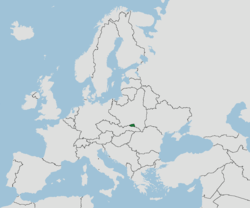Komancza Republic
| Komancza Republic | ||||||||||
| ||||||||||
|
| ||||||||||
 | ||||||||||
| Capital | Komańcza | |||||||||
| Languages | Ukrainian | |||||||||
| Government | Republic | |||||||||
| President | Pantelejmon Shpylka | |||||||||
| Historical era | World War I | |||||||||
| • | Established | 4 November 1918 | ||||||||
| • | Disestablished | 23 January 1919 | ||||||||
| ||||||||||
| Today part of | | |||||||||
The Komancza Republic, also known as the Eastern Lemko Republic (Східно-Ле́мківська Республіка), is an informal name of a short-lived microstate, an association of thirty three Lemko villages, seated in Komańcza in eastern Lemkivshchyna, that existed between 4 November 1918 and 23 January 1919. It was headed by Head of the Council (голова Повітової Української Національної Ради, Head of the powiat Ukrainian National Rada) Panteleymon Shpylka.
Unlike the contemporaneous Lemko Republic to its west, the Komancza Republic planned to unite with the West Ukrainian People's Republic in an independent Ukrainian state. (The Lemko Republic sought unification with the Russian Soviet Republic.) Unification of the Komancza Republic and West Ukraine was suppressed by the Polish government as part of the Polish–Ukrainian War.
The Treaty of Saint-Germain made Galicia west of the San Polish.[1]
List of villages constituting the Republic
References
- ↑ Magocsi, Paul Robert (2002) [1993]. "Central Europe 1918-1923". Historical Atlas of Central Europe. A History of East Central Europe. 1 (revised and expanded ed.). Seattle: University of Washington Press. p. 127. ISBN 0-295-98146-6. OCLC 47097699.
